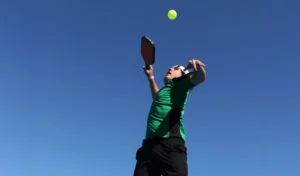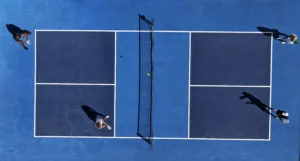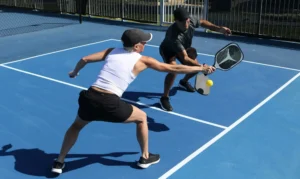
If you’ve ever been on the pickleball court, you’ve probably heard the dink shot being talked about. So, what is a dink, then, and why is it such an important part of your game? If you’re a beginner or just looking to enhance your game, understanding what is a dink in pickleball can take your game to the next level.
The dink is not a power shot—it’s a finesse shot, an accuracy shot, and a control shot. It’s the shot that can drive your opponent nuts, keep you in the rally, and make you the master of the net. Let’s learn about pickleball dinks, why they’re crucial, and how you can be a master of them.
What is a Dink in Pickleball?
A dink shot is an easy, soft shot that drops just above the net in your opponent’s non-volley zone (often referred to as “the kitchen“). Instead of slamming the ball past your opponent, the aim of a pickleball dink is to cause them to respond with an uncoordinated, low shot. A well-played dink forces your opponent to hit up, so they can’t attack and gives you a winning shot.
Why is the Dink important?
Pickleball isn’t a strength sport—games can be won with control. The dink shot is a key strategy to:
- Slows down the game – It breaks up quick, power shots and re-starts the rally.
- Force errors – Opponents tend to pop up the ball, making it easy for you to put it away.
- Take control of the kitchen – If you out-dink your opponent, you’ll own the net.
The best players don’t dink for the sake of dinking—they’re doing it because there’s a reason for it, wearing down the opposing team and waiting for the right time to strike.
How to Make a Perfect Dink Shot
The art of the dink is not just about hitting the ball over the net. It needs control, patience, and a gentle touch. Here is how you do it:
1. Remain Low and Balanced
- Bending knees instead of leaning forward—this is a more stable and ready position to shoot in next.
- Hold your paddle in front of you and remain loose.
2. Hold with a Soft Grip
- Hold your paddle lightly (about 3 or 4 out of 10 on a grip pressure scale).
- A tight grip produces too much power, while a soft grip allows the impact of the ball to be absorbed.
3. Employ a Low Arc
- Your job is just to clear the net and get the ball into the kitchen.
- The more difficult the bounce, the more difficult it is for your opponent to attack.
4. Keep It Unattackable
- If you leave your dink too high, your opponent will smash it back.
- Get the ball short and low, causing them to stretch or step into the kitchen (resulting in faults).
Types of Dink Shots in Pickleball
To make your opponent unsure, mix up your dinks:
1. Straight Dink (Down-the-Line or Crosscourt)
- The most common dink, softly struck into the opponent’s kitchen.
- A crosscourt dink is safer because it gives you more space above the net and a wider angle.
2. Slice Dink
- Put a little backspin on by brushing underneath the ball.
- This causes the ball to remain low and more difficult to attack.
3. Topspin Dink
- A stronger shot where you place a small topspin for additional control.
- Great for putting errors on players who struggle with spin.
4. Surprise Speed-Up Dink
- Disguise a dink and then strike it a bit harder at your opponent’s body.
- If they are anticipating a dink that comes slowly, they may pop it up for a straightforward put-away.
Common Mistakes When Dinking
Even professionals miss their dinks every now and then. Be on the lookout for the following:
- Leaning too far – This places you out of balance and makes it harder to recover.
- Overhitting the dink – When you overhit the dink, you give your opponent an opportunity to play aggressively.
- Striking too high – Too high of a dink = an opponent’s easy smash.
The secret? Remain patient and calm—dinking is waiting for the opportune moment, not trying to force a winner.
Dinking Drills to Improve Your Soft Game
Want to improve your dinking? Try these drills:
- Dink Rally Drill – Stand on the line of the non-volley zone and rally a friend on dinks only. Try to rally the ball for 30+ shots.
- Dink Target Practice – Place cones or markers on the kitchen floor and try to place your dinks in those spots.
- Fast-Hands Drill – Speed up the dinking exchange to train the reaction.
When to Take a Dink Shot in Pickleball
A perfectly placed dink is great, but when do you use it?
- When you’re at the kitchen line and need to slow down a fast rally.
- When your opponent is over-aggressive and you would like to re-set the point.
- Whenever you need to force an error or create a simple attack.
It is equally important to understand when not to dink. If the opposing team is already on the attack, a dink high up is an automatic point for them.
FAQs Regarding Pickleball Dinks
What is a dink in pickleball?
A dink is a soft, controlled shot that lands in the opponent’s kitchen (non-volley zone), keeping the ball low and difficult to attack. This shot is considered a strategic shot in pickleball, forcing opponents into a slower, more strategic rally rather than a fast-paced exchange.Why is dinking so crucial?
Dinking is one of the most important strategies in pickleball because it controls the pace of the game and forces opponents into difficult positions. Here’s why it matters:
- Forces Upward Shots – A well-placed dink makes it hard for opponents to attack, as they have to hit upward, reducing their power and accuracy.
- Controls the Tempo – Dinking slows down the game, shifting play from fast exchanges to strategic rallies where patience and precision matter.
- Creates Attack Opportunities – Consistent, low dinks can eventually draw a high return, setting you up for a winning shot.
- Reduces Errors – Power shots can be risky, but controlled dinks keep the ball in play while forcing your opponent to make mistakes.
Mastering the art of dinking gives you an edge in long rallies, allowing you to dictate play and set up winning shots!
How do I keep low dinks?
Keeping your dinks low is key to controlling the rally and preventing your opponent from attacking. Here’s how to refine your dink game:
- Relax Your Grip – Hold the paddle lightly to maintain better touch and control. A tight grip can lead to excessive power.
- Aim Just Over the Net – Keep your shot low and precise, ensuring it barely clears the net and lands in the opponent’s kitchen.
- Keep a Stable Wrist – A firm wrist prevents unnecessary motion and keeps the ball from popping up too high.
- Use a Gentle, Controlled Motion – Let your paddle absorb the ball’s impact instead of pushing it too hard.
With consistent practice, your low dinks will become a powerful strategic weapon, keeping your opponents off balance and unable to attack!
Is a straight dink or a crosscourt preferable?
Crosscourt dinks afford you more space and make your opponent have to move. Straight dinks are riskier and may function if your opponent is offside.
How do I win a dink battle?
A dink battle is a battle of patience, control, and strategy. To win, you must concentrate on placement and consistency while waiting for your opponent to make a mistake. This is how:
- Stay Relaxed & Controlled – Keep your dinks soft and precise, avoiding unnecessary power.
- Vary Your Placement – Mix up your shots by aiming cross-court, straight ahead, or deeper into the kitchen to keep your opponent guessing.
- Watch for an Opening – Look for a high return or a weak dink, then be ready to attack with a put-away shot.
- Use Spin & Angles – Adding a bit of slice or topspin can make your dinks harder to read and return.
- Be Patient – The goal is to force your opponent into an error or set up an attackable shot—don’t rush it!
Winning a dink battle isn’t about speed; it’s about smart shot placement, control, and waiting for the right moment to strike!
Final Thoughts
A great pickleball dink has nothing to do with winning points—it’s about getting yourself in a position to win. Whether you’re a new player learning what a dink is or developing your soft game, mastering this shot will put you in control on the court.
Take it slow the next time you play, be patient, and dink like a pro!
Now go out there and get those dinks rolling! ????


